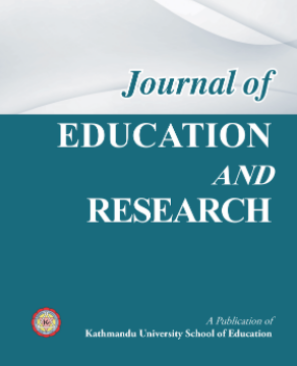
Cultural Gap in Education: Making Education Unresponsive to the Local Needs
Editorial
Journal of Education and Research, Volume 5, Issue 1, 2015, 1-6, https://doi.org/10.3126/jer.v5i1.13054
Publication date: Mar 15, 2015
Views: 371 | Downloads: 147
How to cite this article
APA
In-text citation: (Parajuli, 2015)
Reference: Parajuli, M. N. (2015). Cultural Gap in Education: Making Education Unresponsive to the Local Needs. Journal of Education and Research, 5(1), 1-6. https://doi.org/10.3126/jer.v5i1.13054
Reference: Parajuli, M. N. (2015). Cultural Gap in Education: Making Education Unresponsive to the Local Needs. Journal of Education and Research, 5(1), 1-6. https://doi.org/10.3126/jer.v5i1.13054
Vancouver
In-text citation: (1), (2), (3), etc.
Reference: Parajuli MN. Cultural Gap in Education: Making Education Unresponsive to the Local Needs. Journal of Education and Research. 2015;5(1):1-6. https://doi.org/10.3126/jer.v5i1.13054
Reference: Parajuli MN. Cultural Gap in Education: Making Education Unresponsive to the Local Needs. Journal of Education and Research. 2015;5(1):1-6. https://doi.org/10.3126/jer.v5i1.13054
AMA
In-text citation: (1), (2), (3), etc.
Reference: Parajuli MN. Cultural Gap in Education: Making Education Unresponsive to the Local Needs. Journal of Education and Research. 2015;5(1), 1-6. https://doi.org/10.3126/jer.v5i1.13054
Reference: Parajuli MN. Cultural Gap in Education: Making Education Unresponsive to the Local Needs. Journal of Education and Research. 2015;5(1), 1-6. https://doi.org/10.3126/jer.v5i1.13054
Chicago
In-text citation: (Parajuli, 2015)
Reference: Parajuli, Mahesh Nath. "Cultural Gap in Education: Making Education Unresponsive to the Local Needs". Journal of Education and Research 2015 5 no. 1 (2015): 1-6. https://doi.org/10.3126/jer.v5i1.13054
Reference: Parajuli, Mahesh Nath. "Cultural Gap in Education: Making Education Unresponsive to the Local Needs". Journal of Education and Research 2015 5 no. 1 (2015): 1-6. https://doi.org/10.3126/jer.v5i1.13054
Harvard
In-text citation: (Parajuli, 2015)
Reference: Parajuli, M. N. (2015). Cultural Gap in Education: Making Education Unresponsive to the Local Needs. Journal of Education and Research, 5(1), pp. 1-6. https://doi.org/10.3126/jer.v5i1.13054
Reference: Parajuli, M. N. (2015). Cultural Gap in Education: Making Education Unresponsive to the Local Needs. Journal of Education and Research, 5(1), pp. 1-6. https://doi.org/10.3126/jer.v5i1.13054
MLA
In-text citation: (Parajuli, 2015)
Reference: Parajuli, Mahesh Nath "Cultural Gap in Education: Making Education Unresponsive to the Local Needs". Journal of Education and Research, vol. 5, no. 1, 2015, pp. 1-6. https://doi.org/10.3126/jer.v5i1.13054
Reference: Parajuli, Mahesh Nath "Cultural Gap in Education: Making Education Unresponsive to the Local Needs". Journal of Education and Research, vol. 5, no. 1, 2015, pp. 1-6. https://doi.org/10.3126/jer.v5i1.13054
ABSTRACT
Nepal’s School Sector Reform Program (SSRP) that guided the education development initiatives in the country during the period 2009-15 envisioned that by 2015 “a student has basic life skills to co-exist in the competitive contemporary, global society” (Ministry of Education and Sports, 2008, p. 17). Going further, the Program also noted that its goals are built on “EFA Framework of Action” (p. 18). The global orientation of the reform program was thus very clear. Envisioning to prepare the children for global society and following an EFA framework emphasize the global orientation of Nepali education. The SSRP was not the only plan with global orientation; the first Nepali education development plan prepared in 1955 also had the same orientation. The plan had written “we have become a part of the world, whether we like it or not. We can no longer remain isolated; the world has come to us. How can we meet this world without education?” (Pandey, K. C., & Wood, 1956, p. 83). The global orientation was thus not a new phenomenon in Nepali education and the dream towards becoming international has been there in Nepali education consistently. Continuing with the same dream, SSRP presented the strategy of competitive and contemporary global education for Nepal and Nepalis.
KEYWORDS
---
REFERENCES
---
LICENSE
This work is licensed under a Creative Commons Attribution 4.0 International License.
